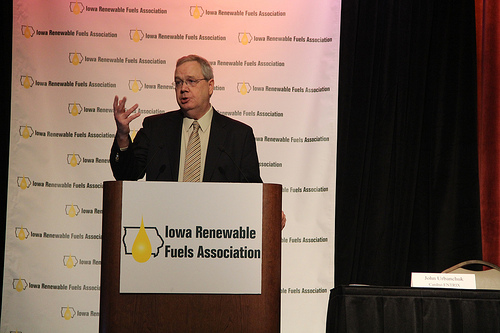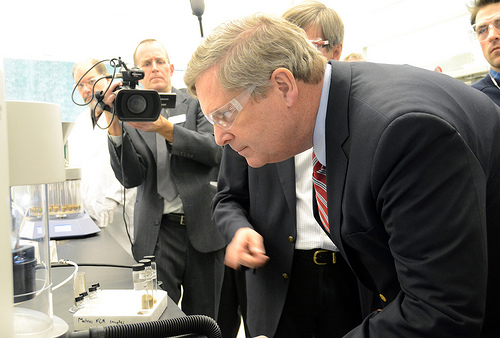
Secretary Vilsack receives the National Energy Leadership Award from the National Biodiesel Board. The award is given periodically to individuals who demonstrate exemplary vision and leadership in development of the renewable fuels industry. Pictured left to right are Ed Ulch, Governing Board Member, National Biodiesel Board; Secretary Tom Vilsack; and Joe Jobe, CEO, National Biodiesel Board.
In the days after the Super Bowl it is not unusual for spectators to “Monday morning quarterback” the advertisements, as well as the plays that were called. For the members of two renewable fuels industries, however, there was no disputing the message of the now famous “God made a farmer” ad featuring Paul Harvey. Last week in Las Vegas, the Renewable Fuels Association and the National Biodiesel Board both led off their meetings with this ad before Secretary Vilsack spoke. It became a starting point to discuss the Secretary’s compelling vision for rebuilding the rural economy, furthering efforts to develop advanced new biofuels, and creating more jobs in our small towns to grow and strengthen the middle class. Read more »
Tags: bio-based economy, biofuels, Farmers, FS, Iowa, jobs, Las Vegas, RD, Rural America, Rural Economy, Tom Vilsack
 Economic Growth, Energy, Rural Development
Economic Growth, Energy, Rural Development
At USDA, we’ve made record efforts in the past four years to support homegrown energy. This year, we’re looking ahead to a promising future for biofuels.
Biofuels have already contributed a great deal to our economy, to our energy security and to the bottom line on our farms and ranches. Today we’re taking steps to strengthen the biofuels industry and helping innovate the next generation of advanced biofuels.
For example, we’ve invested more than $320 million into biofuels research to help accelerate the development of technology needed to take the next big steps. Read more »
Almost three years ago, two biology professors at Delta State University in Mississippi brainstormed how to give science undergraduates research experience in microbiology and entomology.
They hit upon the idea of searching for “science gold” in the bellies of bugs.
Professors Tanya McKinney and Ellen Green received $40,000 through a grant for under-represented colleges from the U.S. Forest Service to help with the project. As part of their research experience, students in the program search the guts of beetle larvae to discover new cellulases, enzymes that break down cellulose, an organic compound that helps make plant cell walls rigid.
Read more »

Under Secretary for Rural Development Dallas Tonsager describes Secretary Vilsack’s “All of the Above” energy strategy during the Iowa Renewable Fuels Summit. USDA photo.
A mid-winter snow storm did not stop more than 200 participants from attending the 7th Annual Iowa Renewable Fuels Summit and Trade Show held January 30th in Des Moines.
During Under Secretary for Rural Development Dallas Tonsager’s presentation it was clear that everyone in attendance was extremely focused on helping identify ways the renewable fuels industry can continue to create economic opportunities in rural America. At the summit Mr. Tonsager also had the opportunity to hear Tom Buis with Growth Energy give a detailed overview of the ethanol industry and its many positive impacts throughout our country. Read more »

Agriculture Secretary Tom Vilsack tours Renmatix's state-of-the-art bioindustrial facility at Renmatix headquarters in King of Prussia, PA on Friday, Jan. 11, 2013, and to commission the company’s new multiple-feedstock processing BioFlex Conversion Unit. Photo property of Renmatix.
If you want proof that rural America is a land of limitless opportunity, go to King of Prussia, Pennsylvania.
Last week I accompanied Secretary Vilsack as he toured a state-of-the-art bioindustrial facility in Pennsylvania that converts multiple feedstocks into cellulosic sugars. The plant, operated by Renmatix, will test and convert a range of non-food plant materials through a proprietary process. The goal is to move forward in development of next-generation renewable energy and high value bio-based alternatives to petroleum-based products. It is a goal that bears enormous promise for rural America, potentially creating many thousands of jobs, untold economic activity and new markets. Read more »
Tags: ARS, bio-based economy, biofuels, FAA, Kansas State University, Navy, Pennsylvania, Renewable Energy, Tom Vilsack, Utah
 Economic Growth, Energy
Economic Growth, Energy
Rob Green’s recent Wall Street Journal op-ed “The cause of higher grocery bills isn’t the drought. It’s the failed federal ethanol policy” fails to take into consideration a host of factors, other than demand for corn, that affect food prices.
In the domestic and global markets commodity, labor, transportation, energy costs, processing, and marketing costs all contribute to what we pay for food in our local grocery store or restaurant. In some cases, factors such as higher oil prices affect one or more of these underlying costs producing higher domestic and world food prices. Read more »



